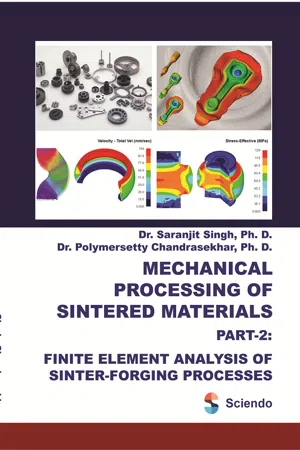![]()
Chapter 1:
Introduction. 1
Chapter 2: Literature
Survey. 19
![]()
Chapter 3:
Basic Experimental Work.
32
![]()
Chapter 4:
Plasticity Model & Finite Element Formulation for Sintered Materials.
66
![]()
Chapter 5:
FEM Analysis of Open-Die Sinter-Forging of different Generic Shaped Preforms.
80
![]()
Chapter 6:
FEM Analysis of Closed-Die Sinter-Forging of Double-Hub Flange Preform.
115
![]()
Chapter 7:
FEM of Rotary Sinter-Forging of Cylindrical Preforms.
128
![]()
Chapter 8:
Conclusions and Scope for Future Work.
145
References
151
vii
LIST OF FIGURES
Figure
Page
Description
No.
No.
1.1
Flow diagram of sinter-forging process.
4
1.2
Sinter-Forging of Connecting Rod.
5
1.3
Illustration of Sinter Forged Components.
8
3.1
(a) & (b): Closed Circular Cavity Powder Compaction Die-Sets.
33
3.2
Closed Square Cavity Powder Compaction Die Set.
34
3.3
Die Set for Closed-Die Sinter-Forging.
34
3.4
Design of Upper Conical Rotary Forging Die and Die Tool Holder.
34
3.5
Illustration of Conical Front End of Rotary Die & Assembled Rotary Forging Die.
35
3.6 (a) UTM for Powder Compaction.
37
3.6 (b) Muffle Furnace.
37
3.7
(a) & (b): Cylindrical Metal Powder Preforms.
39
3.8
Hollow Aluminium Metal Powder Preforms.
39
3.9
Truncated Conical Aluminium Metal Powder Preforms.
39
3.1
Irregular Polygonal Aluminium Metal Powder Preforms.
39
3.11
Trapezoidal Preform with Symmetrical Regions.
40
3.12
Variation of Relative Density with Compaction Pressure.
42
3.13
Variation of Relative Density with Sintering Temperature.
42
3.14
Formation of Cracks on Cylindrical Aluminium Preform.
44
3.15
Variation of Relative Density with Height Reduction during Sinter-Forging of Cylindrical Preforms.
46
3.16
Variation of Radial & Axial Strains with Height Reduction during Sinter-Forging of Cylindrical Preforms.
46
3.17
Variation of Poisson’s Ratio with Height Reduction during Sinter-Forging of Cylindrical Preforms.
47
3.18
Variation of Poisson’s Ratio with Relative Density during Sinter-Forging of Cylindrical Preforms.
47
3.19 Variation of Forgeability with Initial Relative Density during Sinter-Forging of Cylindrical Preforms.
48
3.2
Variation of Densification Rate with Relative Density during Sinter-Forging of Cylindrical Preforms.
48
3.21
Variation of Axial Strain with Forging Load during Sinter-Forging of Cylindrical Preforms.
49
3.22
Photomicrographs of Sinter-Forged Preforms.
50
3.23
Formation of Cracks on Hollow Disc Preform.
52
3.24
Variation of Outer Diameter with Height Reduction during Open-
(a)
Die Sinter-Forging of Hollow Preforms.
52
3.24
Variation of Inner Diameter with Height Reduction during Open-
(b)
Die Sinter-Forging of Hollow Preforms.
53
viii
3.25
Variation Relative Density with Height Reduction during Open-Die Sinter-Forging of Hollow Preforms.
53
3.26
Variation of Die Load with Die Velocity during Open-Die Sinter-Forging of Hollow Preforms.
54
3.27
Formation of Cracks on Truncated Conical Preforms.
55
3.28 Variation of Forging Load with Die Velocity during Open-Die Sinter-Forging of Truncated Conical Preforms.
55
3.29 Variation of Radial & Axial Strain Rates with Height Reduction during Open-Die Sinter-Forging of Truncated Conical Preforms.
56
3.3
Contour Plot of Radial & Axial Strain Rates during Open-Die Sinter-Forging of Truncated Conical Preforms.
57
3.31 Variation of Preform Relative Density with Height Reduction during Open-Die Sinter-Forging of Truncated Conical Preforms.
57
3.32
Symmetrical Regions on the Irregular Trapezoidal Preforms after Open-Die Sinter-Forging Process.
58
3.33
Variation of Relative Density with Height Reduction during Open-Die Sinter-Forging of Irregular Trapezoidal Preforms.
59
3.34
Variation of Die Load with Die Velocity during Open-die Sinter-Forging of Irregular Trapezoidal Preforms.
59
3.35
Sinter-Forged Double-Hub Flange Components.
61
3.36
Variation of Height Reduction with Die Velocity during Closed-Die Sinter-Forging of Double-Hub Flange Component. 62
3.37
Variation of Relative Density with Forging Load during Closed-Die Sinter-Forging of Double-Hub Flange Component.
62
3.38
Variation of Forging Load with Ratio of Unfilled Die Volume to Components' Actual Volume during Closed-Die Sinter-Forging of Double-Hub Flange Component.
63
3.39 Variation of height reduction with upper surface disc diameter during the rotary sinter-forging of cylindrical preforms. 64
3.4
Variation of Relative Density with height reduction during the rotary sinter-forging of cylindrical preforms.
64
4.1
Flow chart of FEM Process.
73
4.2
Quadrilateral element and natural coordinate system.
74
4.3
Tetrahedral element.
76
5.1
Flow Stress Curve of Sintered Aluminium Preform.
83
5.2 Schematic Diagram of Open-Die Sinter-Forging of Hollow Preform. 85
5.3 Models of Meshed 2D Axi-Symmetric and 3D Hollow Preform.ollow disc preformH
85
5.4
Sinter-Forging Stages of Hollow Preform with Smaller Inner Diameter. 87
5.5 Sinter-Forging Stages of Hollow Preform with Larger Inner Diameter. 87
5.6
(a) & (b): Displacement Profiles during Open-Die Sinter-Forging of Hollow Preform with Smaller and Larger Inner Diameter respectivley. 88
ix
5.7
(a) & (b): Effective Strain Distribution during Open-Die Sinter-Forging of Hollow Preform with Smaller and Larger Inner Diameter respectivley. 89
5.8
(a) & (b) : Effective Stress Distribution during Open-Die Sinter-Forging of Hollow Preform with Smaller and Larger Inner Diameter respectivley. 90
5.9
(a) & (b) : Velocity Vector Distribution during Open-Die Sinter-Forging of Hollow Preform with Smaller and Larger Inner Diameter respectivley. 91
5.1
Variation of Effective Strain with Height Reduction during Open-Die Sinter-Forging of Hollow Preform.
92
5.11
Variation of Effective Stress with Height Reduction during Open-Die Sinter-Forging of Hollow Preform.
93
5.12
Variation of Internal Energy with Reduction in Height during Open-Die Sinter-Forging of Hollow Preform.
93
5.13
Variation of Forging Load with Height Reduction during Open-Die Sinter-Forging of Hollow Preform.
94
5.14 Schematic Diagram of Open-Die Sinter-Forging of Truncated Conical Preform.
95
5.15 Models
of Meshed Truncated Conical Preform with Tetrahedral Mesh. 96
5.16 Preform Profiles during Open-Die Sinter-Forging of Truncated Conical Preform.
97
5.17
Distribution of Total Displacement ...
